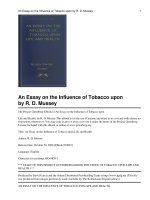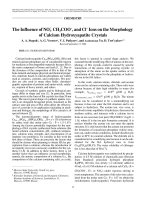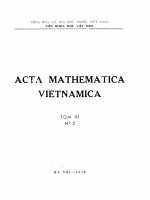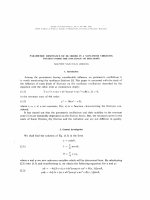Investigating knowledge intensive business services the influence of knowledge, solution characteristics, and environmental turbulence
Bạn đang xem bản rút gọn của tài liệu. Xem và tải ngay bản đầy đủ của tài liệu tại đây (3.73 MB, 276 trang )
INVESTIGATING KNOWLEDGE-INTENSIVE BUSINESS
SERVICES: THE INFLUENCE OF KNOWLEDGE,
SOLUTION CHARACTERISTICS, AND
ENVIRONMENTAL TURBULENCE
XIN YAN
NATIONAL UNIVERSITY OF SINGAPORE
2009
INVESTIGATING KNOWLEDGE-INTENSIVE BUSINESS
SERVICES: THE INFLUENCE OF KNOWLEDGE,
SOLUTION CHARACTERISTICS, AND
ENVIRONMENTAL TURBULENCE
XIN YAN
(M. Eng., National University of Singapore)
A THESIS SUBMITTED FOR THE DEGREE OF
MASTER OF ENGINEERING
DEPARTMENT OF INDUSTRIAL & SYSTEMS ENGINEERING
NATIONAL UNIVERSITY OF SINGAPORE
2009
ACKNOWLEDGEMENTS
It is a nice feeling to finally come to write this page, although I know the long journey
is still not complete. I could not have come to this point without the help from those
who have supported me throughout this long and challenging journey. I would like to
take this opportunity to express my appreciation to all of them.
First of all, I am grateful to all my supervisors for their effort, time, and confidence in
me. Particularly, I am indebted to my supervisor Dr. Chai Kah-Hin at NUS for his
guidance and advice throughout this journey. His enthusiasm, patience, caring, and
understanding have allowed me to think independently and creatively while keeping
on the right track of the research. Without his encouragement, my determination might
not be firm enough to finish this tough job. I also wish to express my sincere gratitude
to my co-supervisor, Associate Professor Tan Kay Chuan at NUS, for his support and
valuable comments on the research. I was glad that Prof. Tan and I had the opportunity
to attend the Frontiers in Service Conference in 2006. His caring made me feel I was
not alone in that unfamiliar place. At TU/e, I would like to thank my supervisor,
Professor Aarnout Brombacher, for his utmost support, professional guidance, and
precious advice. During my stay at TU/e from 2007 to 2008, we had lots of efficient
and fruitful discussions, many of which have been incorporated in this dissertation.
Not only is Professor Brombacher a supervisor, he is also a friend who made my life in
Eindhoven interesting. Participating in the ‘Eindhoven Marathon 2007’ was an
amazing experience that I had never imagined.
I wish to further thank my fellow colleagues in the Engineering Management group at
NUS. Thanks for being such great teachers and friends: Awie, Ding Yi, Hongling,
Ineke, Lin Jun, Neslihan, Ren Yu, Shifeng, Xiaoyang, Yufeng, and Zhouqi, just to
name a few. I want to especially thank Wang Qi and Darrel for their caring when I
transferred from Singapore to the Netherlands. I am also very grateful to the colleagues
and staff in the ID department at TU/e for their kind help. They include Aylin,
Christelle, Ilse, Jeroen, Joël, Kostas, Maurits, and Wim. I enjoyed jogging with you!
Particularly, thanks to Lu Yuan, Jan Rouvroye, and Hanneke Driessen, who helped me
adapt to life and culture in the Netherlands. And, Josephine, my office-mate, I will
always remember our interesting discussions on everything!
i
I especially thank my project collaborator, Ville Ojanen at Lappeenranta University of
Technology in Finland, for his ever willing help. His ideas broadened my mind on this
particular topic. I loved the experience in Lappeenranta with your family! Also, I wish
to thank Dr. Hu Jun in the ID department at TU/e, for his technical support on
conducting the web-survey.
I am happy to have met my friends Aoran, Fanfan, Qingpei, Shen Yan, Sicong, Suyi,
Wang Yuan, Yanjun, Yin Jun, Yinghui, Zhou Peng, and
so many others, who made
my stay in the ISE department an enjoyable and memorable one. I also thank my
friends in the Netherlands, including Karshif, Fernando, Hejie, Jianhua, Liu Bo, Song
Yang, Wang Bo, Wang Kun, Youbin, Yuanyuan, Yuki, and many others, for making my
life in that lonely and small city a colorful and unforgettable one.
I greatly acknowledge the support from Design Technology Institute and ISE
department for providing me with a research scholarship and the utilization of the
facilities in the Quality & Reliability Engineering Lab, which was essential to the
completion of this project.
Nothing can repay the love and silent support of my dearest parents. Everything I have
achieved is a tribute to you both. Thanks to my beloved brother for his support all
along. The final but the greatest ‘thank you’ I would like to give is to Xiangrui, my
husband, best friend, and partner in life, for all his understanding, considerateness, and
support. This journey is more meaningful because of you!
XIN Yan, Dec 2009
ii
TABLE OF CONTENTS
ACKNOWLEDGEMENTS .......................................................................................... i
TABLE OF CONTENTS.............................................................................................iii
SUMMARY…… .......................................................................................................... vi
LIST OF TABLES......................................................................................................viii
LIST OF FIGURES ...................................................................................................... x
LIST OF NOMENCLATURE .................................................................................... xi
LIST OF ABBREVIATION IN DATA ANALYSIS.................................................. xii
CHAPTER 1 Introduction....................................................................................... 1
1.1 Research background and motivation................................................................... 1
1.2 Research Objective ............................................................................................... 4
1.3 Structure of the dissertation .................................................................................. 5
CHAPTER 2 Literature Review ............................................................................. 8
2.1 Introduction........................................................................................................... 8
2.2 Absorptive capacity............................................................................................... 8
2.2.1 A brief overview of knowledge-based view of firms .................................... 8
2.2.2 Definition of absorptive capacity................................................................. 11
2.2.3 Dimensions of absorptive capacity .............................................................. 12
2.2.4 Antecedents, outcomes, and contingents of absorptive capacity................. 16
2.2.5 Absorptive capacity, organizational learning, and dynamic capabilities..... 20
2.2.6 Summary of absorptive capacity review...................................................... 23
2.3 Service Innovation .............................................................................................. 28
2.3.1 Service and its characteristics ...................................................................... 29
2.3.2 Service innovation definition and process ................................................... 32
2.3.3 The types of service innovation ................................................................... 34
2.3.4 Service innovation practice in companies ................................................... 37
2.3.5 Summary on service innovation studies ...................................................... 40
2.4 Knowledge-Intensive business services (KIBS)................................................. 41
2.4.1 KIBS definition, range, and type ................................................................. 41
2.4.2 KIBS characteristics .................................................................................... 43
2.4.3 KIBS’s role in innovation system................................................................ 44
2.4.4 Knowledge management and innovation in KIBS ...................................... 48
2.4.5 Summary of KIBS studies ........................................................................... 52
2.5 Research gaps and research questions ................................................................ 54
CHAPTER 3 Theory and Hypotheses .................................................................. 60
3.1 Introduction......................................................................................................... 60
3.2 Exploratory interviews........................................................................................ 60
3.3 Working definition of knowledge sources, competitive advantage and the
dimensions of absorptive capacity............................................................................ 67
3.4 Hypotheses on direct effects ............................................................................... 70
3.4.1 Knowledge and its impact on absorptive capacity....................................... 71
3.4.2 Absorptive capacity and its impact on competitive advantage.................... 77
3.5 Hypotheses on moderating effects ...................................................................... 84
3.5.1 Moderating effects of IHIP .......................................................................... 84
3.5.1.1 The moderaitng effects of intangibility..................................... 84
3.5.1.2 The moderating effects of heterogeneity .................................. 86
iii
3.5.1.3 The moderating effects of inseparability .................................. 88
3.5.1.4 The moderating effects of perishability .................................... 90
3.5.2 The moderating effects of environmental turbulence .................................. 91
3.6 Summary............................................................................................................. 96
CHAPTER 4 Survey Instrument Development and Implementation............... 98
4.1 Introduction......................................................................................................... 98
4.2 Measures ............................................................................................................. 98
4.2.1 Measures: key model variables.................................................................... 98
4.2.2 Measures: moderating variables ................................................................ 101
4.2.3 Measures: control variables ....................................................................... 102
4.2.4 Summary of measures................................................................................ 103
4.3 Questionnaire design......................................................................................... 103
4.3.1 Questionnaire structure .............................................................................. 103
4.3.2 Pre-test of the questionnaire ...................................................................... 104
4.3.3 Translation issues of the questionnaire...................................................... 104
4.4 Survey implementation ..................................................................................... 105
4.4.1 Target population....................................................................................... 105
4.4.2 Survey implementation .............................................................................. 106
4.5 Summary........................................................................................................... 107
CHAPTER 5 Data Analysis, Results, and Discussion ....................................... 108
5.1 Introduction....................................................................................................... 108
5.2 Data analysis ..................................................................................................... 108
5.2.1 Descriptive analysis ................................................................................... 108
5.2.1.1 Check on errors, assumptions, non-response bias, and single vs.
multiple respondents ........................................................................... 109
5.2.1.2 Descriptive results................................................................... 112
5.2.2 Measurement model................................................................................... 114
5.2.2.1 Exploratory factor analysis and common method bias ........... 115
5.2.2.2 Confirmatory factor analysis .................................................. 117
5.2.3 Structural model......................................................................................... 124
5.3 Results and discussion ...................................................................................... 137
5.3.1 Results and discussion about descriptive statistics .................................... 137
5.3.2 Results and discussion on direct effects .................................................... 139
5.3.2.1 Results and discussion about knowledge source and its impact
on absorptive capacity ........................................................................ 139
5.3.2.2 Results and discussion about absorptive capacity and its impact
on competitive advantage ................................................................... 141
5.3.3 Results and discussion on moderating effects ........................................... 143
5.3.3.1 Results and discussion about moderating effects of intangibility
............................................................................................................ 143
5.3.3.2 Results and discussion about moderating effects of
heterogeneity....................................................................................... 146
5.3.3.3 Results and discussion about moderating effects of
inseparability....................................................................................... 147
5.3.3.4 Results and discussion about moderating effects of perishability
............................................................................................................ 148
5.3.3.5 Results and discussion about moderating effects of
environmental turbulence ................................................................... 149
iv
5.3.4 Results and discussion on other effects ..................................................... 152
5.4 Summary........................................................................................................... 153
CHAPTER 6 Conclusion and Future Studies .................................................... 156
6.1 Introduction....................................................................................................... 156
6.2 Main findings of the study ................................................................................ 156
6.3 Contributions and implications of the study ..................................................... 157
6.3.1 Contributions and implications to researchers........................................... 157
6.3.2 Contribution and implication to practitioners ............................................ 162
6.4 Limitations of the study and future directions .................................................. 165
6.5 Conclusion ........................................................................................................ 168
REFERENCE…........................................................................................................ 170
Appendix A - Road map of Survey .......................................................................... 195
Appendix B - Questionnaire (Web version, English)............................................. 206
Appendix C - Questionnaire (Web version, Finnish)............................................. 228
Appendix D - Tables on Data Analysis for Chapter 5............................................ 250
Appendix E – Guidelines for Exploratory Interviews……………………………260
v
SUMMARY
The service sector is more and more important for the modern economy. Service firms
today are expected to delight customers with their creativity and innovation to achieve
competitive advantage. As one of the most important service sectors in many
industrialized countries, knowledge intensive business services (KIBS) differ
significantly from those services focusing on individuals and consumer markets. The
overall objective of this study is to improve the understanding of how knowledge
contributes to competitive advantage in KIBS. It presents opportunities to further our
understanding on absorptive capacity—its antecedents, dimensions, and effects on
competitive advantage—in KIBS firms.
Data is collected from a web-survey of 327 new technology based KIBS firms in
Finland. Results from structural equation modeling analysis provide encouraging
support to the proposed framework in this study. The results show that absorptive
capacity is more a result of internally accumulated knowledge, rather than externally
gathered knowledge. This suggests that KIBS firms should pay more attention to
accumulating internal related knowledge to achieve competitive advantage. Except for
knowledge
exploitation,
capacity—knowledge
all
the
other
identification,
three
knowledge
dimensions
acquisition,
of
absorptive
and
knowledge
transformation—contribute to both dimensions of competitive advantage, i.e.
innovation and strategic flexibility. In particular, knowledge acquisition is the most
important contributor to strategic flexibility while knowledge transformation is the
most important contributor to innovation.
Based on our KIBS firms’ context, four service characteristics, i.e. intangibility (I),
heterogeneity (H), inseparability (I), and perishability (P), plus environmental
vi
turbulence are used as the contingents in the absorptive capacity construct. The results
from a hierarchical multiple regression analysis suggest that the direct effects of the
antecedents on absorptive capacity and the direct effects of absorptive capacity on
competitive advantage are moderated by the IHIP level of the solutions and the level of
environmental turbulence.
For more intangible solutions, prior related knowledge will contribute more to
knowledge exploitation, and external knowledge sourcing will contribute less.
Similarly, external knowledge sourcing contributes less to knowledge exploitation
when the solution has a higher level of perishability. The positive relationship between
knowledge identification and strategic flexibility increases for solutions with higher
levels of perishability and for environments with higher market and technological
turbulence. The positive effect of knowledge acquisition on strategic flexibility will be
stronger when in high turbulent environments and its positive impact on innovation
will be stronger when the solution inseparability is higher. When the solution
heterogeneity and inseparability are higher, knowledge transformation contributes less
to strategic flexibility and innovation. However, knowledge transformation contributes
more to innovation when environmental turbulence is higher.
vii
LIST OF TABLES
Table 2-1 Dimensions of absorptive capacity............................................................... 13
Table 2-2 Some important studies on absorptive capacity............................................ 24
Table 2-3 Service characteristics .................................................................................. 31
Table 2-4 Categorization of service innovation based on innovativeness .................... 36
Table 2-5 Two groups on KIBS (adapted from Miles et al., 1995)............................... 42
Table 3-1 Background of company and interviewee .................................................... 62
Table 3-2 Content analysis of the interviews—frequency counts of important points. 63
Table 3-3 Preliminary findings ..................................................................................... 67
Table 5-1 KMO and Bartlett’s test……………………………………………...……115
Table 5-2 Confirmatory factor analysis results………………………………………119
Table 5-3 Correlations and square roots of AVE of measurement model……………121
Table 5-4 Discriminant validity for measurement model— χ differenc……………122
2
Table 5-5 Fit indices for alternative measurement models…………......……………123
Table 5-6 Descriptive statistics and inter-correlations…………………………….…124
Table 5-7 Fit indices for the alternative structural models………...………………...126
Table 5-8 Results from path model analysis—direct effects and moderating effects of
IHIP characteristics—Model 8……………………………………………….……...129
Table 5-9 Results from path model analysis—direct effects and moderating effects of
environmental turbulence—Model 9………………………………………………..135
Table 5-10 Effects of KEXT on KE - Comparison between different INT levels…..145
Table 5-11 Moderating effect of ET on the relationship between KI and SF…….…150
Table 5-12 Hypotheses testing results…………………………………………….…155
Table 6-1 An overview of research questions and findings of the study…………….157
Table D-1 Descriptive statistics………………………………………………….…..251
Table D-2 Non-response bias test - Size……………………………………………..252
viii
Table D-3 Non-response bias test - Age…………………………………………..…252
Table D-4 Non-response bias test – Innovativeness..……………………………..…253
Table D-5 Non-response bias test – Other variables…………………………………253
Table D-6 T-test on size for single and multiple responses companies……...………254
Table D-7 Job titles of respondents……………………………………………….…254
Table D-8 Size of the response firms…………………………………………….…..255
Table D-9 Industry categories of the response firms—service vs. manufacturing…..255
Table D-10 Companies in service & manufacturing………..……………………….255
Table D-11 Companies in Service…………………………………………………...256
Table D-12 Innovation type………………………………………………………….256
Table D-13 Contribution of radical innovation on annual sales……………………..256
Table D-14 Major service provided………………………………………………….257
Table D-15 External knowledge source and method to get external knowledge…....257
Table D-16 Factor loadings with varimax rotation—EFA………………………..…258
Table D-17 T-test for radical and incremental innovation…………………...………259
Table D-18 KEÆINNO in high innovative firms………………...…………………259
ix
LIST OF FIGURES
Figure 1-1 Structure of the thesis.................................................................................... 7
Figure 2-1 A model of absorptive capacity (adopted from Zahra and George 2002)........... 17
Figure 2-2 A model of absorptive capacity (adopted from Todorova and Durisin 2007) ..... 19
Figure 2-3 Service innovation process.......................................................................... 34
Figure 2-4 Four dimensions of innovation in services (adapted from den Hertog et al, 2003) 37
Figure 2-5 Knowledge interaction with clients in KIBS (adapted from Strambach, 2001) 50
Figure 2-6 Conceptual framework…………………………………………………….59
Figure 3-1 Research framework ................................................................................... 97
Figure 5-1 Structural model without the interaction effects and the relationships
between absorptive capacity dimensions—Model 5………………...…………....…125
Figure 5-2 Structural model without the interaction effects but with the relationships
between absorptive capacity dimensions—Model 6……………………….. …..
126
Figure 5-3 INT x KPRI on KE…………………………………………………..…..131
Figure 5-4 INT x KEXT on KAC……………………………………...…….………131
Figure 5-5 INT x KEXT on KE…………………………………………….………..131
Figure 5-6 HET x KT on SF…………………………………………….......……….132
Figure5-7 INS x KAC on INNO…………………………………………………….133
Figure5-8 INS x KT on INNO.…………………………………………….………..133
Figure 5-9 PER x KEXT on KE…………………………………………………..…134
Figure 5-10 PER x KI on SF…………………………………………………………134
Figure 5-11 ET x KT on INNO………………………………………………..……..136
Figure 5-12 ET x KAC on SF………………………………………………….…….136
Figure 5-13 MT x KI on SF………………………………………………….………136
Figure5-14 TT x KI on SF…………………………………………………………...136
Figure 5-15 Hypotheses testing results………………………………………...…….138
Figure 5-16 MT x KI on SF…………………………………………………...……..151
Figure 5-17 TT x KI on SF…………………………………...……………………...151
x
LIST OF NOMENCLATURE
AVE
average variance extracted
CFA
confirmatory factor analysis
EFA
exploratory factor analysis
ICT
information and communication technology
IHIP
intangibility, heterogeneity, inseparability, and perishability
KBV
knowledge-based view
KIBS
Knowledge-intensive business services
KMO
Kaiser-Meyer-Olkin
PAC
potential absorptive capacity
RAC
realized absorptive capacity
RBV
resource-based view
SEM
structural equation modeling
t-KIBS
new technology-based knowledge-intensive business services
TEC
technology and engineering consultancy
xi
LIST OF ABBREVIATION IN DATA ANALYSIS
Outcome variables
CA
competitive advantage
INNO
innovation
SF
strategic flexibility
Independent variables
KEXT
external knowledge sourcing
KPRI
prior related knowledge
Absorptive capacity variables
KI
knowledge identification
KAC
knowledge acquisition
KASknowledge assimilation
KT
knowledge transformation
KE
knowledge exploitation
Moderating variables
INT
intangibility
HET
heterogeneity
INS
inseparability
PER
perishability
ET
environmental turbulence
COMP
competitive intensity
MT
market turbulence
TT
technological turbulence
xii
Chapter 1
CHAPTER 1
Introduction
Introduction
1.1 Research background and motivation
The 1990s saw much wider acknowledgement of the ways in which services can be
significant contributors to wealth creation (Miles, 1993). Today, the services sector
offers a tremendous potential for growth and profitability for many countries. Not only
is this true for service firms such as banks, it is also true for manufacturing companies.
Because of the saturation in their core product markets, manufacturing companies in
search of growth are increasingly turning to services (Carmen and Langeard, 1980;
Fitzsimmons and Fitzsimmons, 1999; Zeithaml and Bitner, 2002). For instance, Philips
now offers industrial design services to product manufacturers through its Philips
Design Consulting. Nokia provides product development and engineering consultancy
to mobile phone and IC manufacturers. IBM offers business solutions to many
companies through its IBM Consulting. Service has become a business essential in
manufacturing (Zeithaml and Bitner, 1996), such that management literature suggests
product manufacturers should integrate services into their core product offerings
(Gadiesh and Gilbert, 1998; Quinn, Doorley and Paquette, 1990; Wise and
Baumgartner, 1999). As indicated by Edvardsson, Gustafsson, Johnson and Sandén
(2000), in the long run, all activity is directed towards producing services or conditions
for services. Innovation is the key to survival for most firms, especially service firms
(Agarwal, Drramilli and Dev, 2003). So service firms today are expected to delight
customers with their creativity and innovation to achieve competitive advantage
(Kandampully, 2002).
Knowledge-intensive business services (KIBS) is one of the most important service
sectors in many industrialized countries (Strambach, 2001). Knowledge-intensive
1
Chapter 1
Introduction
services in business-to-business environments differ significantly from those services
focusing on individuals and consumer markets. This sector serves as sources of
important new technologies, high-quality, high-wage employment, and wealth creation
(Tether, 2004). Some KIBS are well known for their innovation, such as IDEO, the
world’s leading design consultancy, which specializes in turnkey product development
and innovation strategy, straddling both sides of the innovation business as both
practitioners and advisers (Kelley with Littman, 2001). In addition to getting help on
designing innovative products, now, IDEO’s clients even seek advice on the IDEO way
of innovating. T-KIBS (new technology based KIBS) form a sub-sector of KIBS. They
are considered as services and/or companies that have high-level technological and/or
other competencies based on a highly educated and motivated work-force as well as
accumulated special knowledge, which plays an especially significant role in the
long-term innovation development in their industry. However, rather than looking at
innovation within the KIBS firms, most of the existing literature on KIBS focuses on
their agent role to their clients’ innovation processes and their contribution to the
regional or national innovation system (den Hertog, 2000; Hauknes, 1998). All of the
above motivate us to investigate how firms may gain innovation, which is one
dimension of competitive advantage, in KIBS, especially in t-KIBS.
Innovation is a knowledge management process (Madhavan and Crover, 1998) and a
learning process (Witt, 1993). It is the result of the generation, acquisition, and use of
new or new combinations of technologies or other substantive investments in new
knowledge (Eurostat, 1995; Nonaka and Takeuchi, 1995; Witt, 1993). According to the
knowledge-based view, differences in innovative performance between firms are a
result of dissimilar knowledge sources (Barney, 1991; Bierly and Chakrabarti, 1996).
This is especially so in the case of knowledge intensive services, where the
2
Chapter 1
Introduction
competitive advantage is strongly dependent on ability to codify the individual tacit
knowledge into collective knowledge to provide service innovations (Leiponen, 2006).
In addition to the firm’s own knowledge stock, its success is dependent on absorptive
capacity, which according to the definition (Cohen and Levinthal, 1990) is the ability
of a firm to recognize the value of new, external information, assimilate it, and apply it
to commercial ends. KIBS firms generate and sell business solutions to their customers,
and these solutions are generated using the collective experiences of the firm. Growth
and globalization, coupled with recent advances in information technology, have led
many of these firms to introduce sophisticated knowledge management systems in
order to create a sustainable competitive advantage (Ofek and Sarvary, 2001).
KIBS
provide a useful empirical context for exploring the relationship between knowledge
management and innovation, as the content of the service itself is to transfer
information, design, or knowledge to the client firm (Miles, Kastrinos, Flanagan,
Bilderbeek, den Hertog, Huntink and Bouman, 1995). Therefore, it may be fruitful to
investigate competitive advantage, especially innovation, in KIBS from a knowledge
management point of view.
Some parts and characteristics of innovations in services are similar to those of
manufacturing and pure physical products but for many parts they are different
(Coombs and Miles, 2000; Drejer, 2004; Howells and Tether, 2004). The differences in
many cases are said to be caused by the typical service characteristics, such as
intangibility (I) , heterogeneity (H) , inseparability (I), and perishability (P) (de Jong
and Vermeulen, 2003; Edvardsson et al, 2000). The output of KIBS is its service or
solutions to customers, therefore the service characteristics (IHIP) should be
considered in knowledge management and innovation in the KIBS context. Because
knowledge is contextual, the knowledge in a given period of time is likely to lose its
3
Chapter 1
Introduction
value as it becomes irrelevant in subsequent periods. According to Glazer and Weiss
(1993), in industries characterized by high turbulence, the value of knowledge tends to
depreciate faster because of the high levels of inter-period uncertainty. Therefore, the
influence of different levels of environmental turbulence should also be considered in
the KIBS context.
1.2 Research Objective
There are some research gaps that are worth investigating, motivated by industry and
academic needs as indicated in the previous section.
Firstly, there is a need for in-depth studies that increase knowledge of the innovations
as well as underlying mechanisms and procedures, which make the innovations
successful in KIBS, especially in t-KIBS. The bulk of the published literature on
service innovation has been concerned with the development of new financial services,
and it is only in recent years that researchers have begun to address issues concerned
with the many different services that exist today. KIBS, especially t-KIBS, occupies a
dynamic and central position in ‘new’ knowledge-based economies and has not been
investigated in depth.
Secondly, it is worth investigating the effects of absorptive capacity in the relationship
between knowledge and competitive advantage in the KIBS context. Most studies on
absorptive capacity tend to consider absorptive capacity as a whole rather than
distinguishing absorptive capacity into its different dimensions. Similarly, different
dimensions of competitive advantage have also rarely been distinguished. Different
antecedence may have differing effects on the dimensions of absorptive capacity, and
different dimensions of absorptive capacity may have differing effects on different
4
Chapter 1
Introduction
dimensions of competitive advantage, such as innovation and strategic flexibility
(Zahra and George, 2002). It would be useful to test all of these effects separately.
Thirdly, there is a need to study further the effects of the contingents such as IHIP and
environmental turbulence, in the relationships mentioned above. In the framework of
absorptive capacity, the contingents mentioned are mostly in theory without any
empirical testing. Thus, operationalizing the contingents might be fruitful for further
understanding the absorptive capacity framework.
Therefore, this research is directed at validating and enhancing the absorptive capacity
framework in the KIBS, especially t-KIBS, context. Accordingly, the aim of this study
is: (1) to examine the role of the different dimensions of absorptive capacity in the
relationship between knowledge and competitive advantage in the KIBS context; and
(2) to examine the role of IHIP and environmental turbulence in the relationships
mentioned above. By doing so, we hope to enhance the understanding of how certain
levels of different dimensions of absorptive capacity may contribute to achieving
various consequences of competitive advantage in the KIBS context, and find out
which dimension is more critical.
1.3 Structure of the dissertation
The dissertation consists of seven chapters. The other chapters are organized as
follows:
First, a detailed review of the relevant literature in three relevant areas, i.e. absorptive
capacity, innovation, and KIBS, is provided in Chapter 2. This chapter concludes with
a discussion of the limitations of the previous studies where research questions will be
raised.
5
Chapter 1
Introduction
In Chapter 3, hypotheses on both direct effects and moderating effects are proposed
based on the existing literature and complemented by exploratory case studies. These
hypotheses include: (1) the impact of knowledge sources
(internal prior related
knowledge and external knowledge sourcing) on different dimensions of absorptive
capacity (knowledge identification, knowledge acquisition, knowledge transformation,
and knowledge exploitation); (2) the impact of different dimensions of absorptive
capacity on different dimensions of competitive advantage (innovation and strategic
flexibility), and (3) the moderating effects of IHIP and environmental turbulence on
the direct effects above in the absorptive capacity construct.
Chapter 4 describes the questionnaire design, measures for the relevant variables, and
survey implementation.
Chapter 5 presents the results of data analysis that used to validate the hypotheses we
developed in Chapter 3. Discussion of the results is also included.
Chapter 6 concludes with the theoretical and practical implications of our research.
Limitations and potential future research directions are discussed at the end.
Figure 1-1 (on next page) shows the structure of the thesis.
6
Chapter 1
Introduction
Figure 1-1 Structure of the thesis
7
Chapter 2
CHAPTER 2
Literature Review
Literature Review
2.1 Introduction
The main objective of this study is to investigate how knowledge affects a firm’s
competitive advantage (especially innovation) through absorptive capacity in KIBS
firms. The extant literature from three main areas is reviewed in this chapter. First, we
focus on the relevant literature on absorptive capacity. Second, we review literature on
service innovation, since innovation is commonly mentioned as an outcome of
absorptive capacity. After that, we review the literature on KIBS which is one of the
most important sectors in services, and where knowledge is its main resource. Finally
we conclude with a discussion of the limitations of previous studies and the research
questions raised.
2.2 Absorptive capacity
In recent decades, absorptive capacity has become one of the most important emerging
constructs in organizational research (Lane, Koka and Pathak, 2006). In this section, a
brief overview of knowledge-based view of firms will be presented. Then, the
definition, dimensions, antecedents, outcomes, and contingents of absorptive capacity
will be focused. Finally, the relation among absorptive capacity, organizational
learning, and dynamic capabilities will be discussed.
2.2.1 A brief overview of knowledge-based view of firms
According to the resource-based view (RBV) of firms, organizations possess numerous
resources, but only those unique, inimitable, and valuable resources are central to
competitive advantage (Barney, 1986, 1991; Prahalad and Hamel, 1990; Wernerfelt,
8
Chapter 2
Literature Review
1984). The knowledge-based view (KBV) of the firms argues that firm specific
knowledge is an example of such a resource. It can be considered the most
strategically significant resource of the firm because it is central to many
organizational activities and processes such as management of technology,
organizational learning, managerial cognition, and organizational innovation (Grant,
1996a). Especially, firm-specific knowledge allows the organization to build
sustainable competitive advantage due to the tacitness (Nonaka, 1994) and stickiness
(Szulanski, 1996) nature of such knowledge which prevents imitation from competing
organizations.
Products do not fully embody the knowledge of a firm, and the knowledge required by
a given product may not be entirely available from within the firm that supplies it (Lee
and Veloso, 2008). While the RBV focuses on the use of internal organizational
resources and capabilities (Barney, 1991) to achieve competitive advantage in a
selected environment, the relational view (Dyer and Singh, 1998) has been offered as
an alternative perspective. Like the RBV, the relational view argues that competitive
advantage is derived from unique and valuable resources. However, the relational view
contends that the resources or capabilities needed by the firm may reside outside the
firm and are accessed or created by building relationships with other firms (Douglas
and Ryman, 2003), which is consistent with KBV. KBV extends RBV because it
examines both the exploitation of existing firm resources and the firm’s ability to
develop new capabilities and access knowledge beyond firm boundaries (Grant and
Baden-Fuller, 2004). Many researchers suggest that employing the KBV as a
theoretical frame for examining the boundaries of the firm can generate many new and
valuable insights (Brouthers and Hennart, 2007; Liebeskind, 1996; Zhao et al., 2004).
In particular, KBV may extend understanding of firm boundaries because it explicitly
9
Chapter 2
Literature Review
recognizes knowledge as a critical resource.
Processing valuable, rare, inimitable, and non-substitutable resources is a necessary
but insufficient condition for value creation. A firm’s resource management process
can produce different outcomes for organizations holding similar resources and facing
similar environmental contingences (Zott, 2003). Therefore, heterogeneity in firm
outcomes under similar initial conditions may result from choices made in the
structuring, bundling, and leveraging of resources (Sirmon et al., 2007). The processes
by which firms obtain or develop, combine, and leverage resources to create and
maintain competitive advantages are not well understood (Sirmon et al., 2007).
The understanding of how a firm can manage knowledge is an issue that has received
increasing attention in both theory and practice over the past ten years. On the basis of
KBV, knowledge and the capability to create and utilize such knowledge are the most
important sources of competitive advantage (Grant, 1996b; Henderson and Cockburn,
1994; Kogut and Zander, 1996; Nelson, 1991; Nonaka and Takeuchi, 1995; Prahalad
and Hamel, 1990). The understanding of how knowledge flows, and how it is
integrated throughout an organization are critical capabilities to the improvement of a
variety of organizational processes (Grant, 1996a). According to Nickerson and Zenger
(2004: 618), the purpose of the knowledge-based view of the firm is “…the critical
question is not whether knowledge should be owned or acquired in the market or how
the exchange of knowledge should be facilitated, but rather how a manager should
organize individuals to generate knowledge that the firm seeks”.
10









